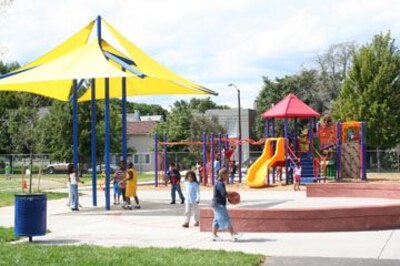Colorado isn’t sweltering the way the eastern U.S. is this summer but, in the long run, the state’s elevation actually makes the sun more dangerous here.

A 2004 survey found almost half of white adults in Colorado had at least one sunburn in the past year, and sunburns are a significant risk factor for skin cancer. Diagnoses of melanoma, responsible for 75 percent of skin cancer deaths, are 15 percent higher in Colorado than in the rest of the country.
That’s why a number of Colorado schools and school districts – aided by state and local health departments – are beginning to adopt sun safety policies and be more intentional about introducing sun protection information into classrooms.
Just this spring, Tri-County Health Department distributed “sun safe tool kits” to all 15 school districts in Adams, Arapahoe and Douglas counties, in hopes the districts will adopt some of the suggested sun safety strategies.
“We can’t really say how it’s going yet because we just distributed them,” said Stacy Weinberg, director of epidemiology, planning and communication for Tri-County.
“Our plan is to evaluate it next spring, but our goal is to disseminate the various strategies the superintendents deem appropriate, and look at strategies that can focus on policy change or systems change to increase sun safety.”
Included in the tool kit:
- Various Sun Safe classroom curricula, including the Environmental Protection Agency’s Sun Wise curriculum and the Sunny Days Healthy Ways curriculum developed in Colorado by Klein Buendel, a small health education and communication research business in Lakewood.
- Model sun safety policies developed by Sun Safe Colorado.
- Resources for designing and funding playground shade structures.
- Assistance in training faculty and staff in sun safety measures.
State policies matter little to local districts
Researchers from Klein Buendel, which launched the Sun Safe Colorado program five years ago with a grant from the Colorado Department of Health, recently partnered with the National Cancer Institute to study what it takes to get schools to adopt sun safe policies.
Targeted in the study were 112 districts in Colorado and in California.
Findings of the study won’t be made public until they are published later this year in the American Journal of Preventive Medicine. But some differences between the two states became clear, said Ilima Kane, program manager of Klein Buendel.
“I can tell you, anecdotally, that Colorado is much more a local control state than California is,” Kane said.
“In California, policy comes from the top down. If the state says something is a good idea, most districts will adopt it much more easily than in Colorado. Here, the attitudes around state policy are quite different.”
Colorado schools ahead in the game
But even without state sun safety policies to guide them, many Colorado schools and school districts are far ahead of the game compared to schools nationwide, Kane said.
“We’re doing well with schools,” she said. “Probably only six or seven states in the nation are really targeting sun safety, and Colorado is one of those. Unfortunately, we also have some of the fastest-increasing skin cancer rates in the country, due to the elevation, the number of sunny days and the Colorado outdoor lifestyle.”
Rural schools districts have been especially receptive to adopting sun safety procedures.
“It’s a big issue among our farmer populations,” she said.
Districts try a variety of strategies
Around the state, different districts and individual schools are taking a variety of steps to address sun safety. Among them:
- In Steamboat Springs, dermatologist Dr. Sandi Eivins started a safety program at the Christian Heritage School this spring, including educating students about skin cancer and ultraviolet exposure. She also provided broad-rimmed sun-protective hats for all the students. When classes resume in the fall, the school will encourage all teachers and students to wear hats and sunscreen.
- La Junta Intermediate School in La Junta got grant money to buy educational materials, a supply of sunscreen and lip balm for students, and a UV meter. It also built a shade structure on the school playground.
- Students at Jefferson County’s Conifer High School researched, wrote, filmed and edited and sun safety awareness movie, which was distributed school-wide on DVD, and the school bought sunscreen and lip balm for student use.
- In Greeley, students at Northridge High School staged a Sun Safe Pre-prom fashion show, to encourage others not to try and tan before the prom.
- Adams County District 14 in Commerce City has adopted a district-wide sun safety policy that includes encouraging students to wear sunscreen and protective clothing when outside, and shade trees and shade structures are being added in three school gardens. “One of the challenges we’ve come up against is that we’re a high poverty district,” said Rainey Wikstrom, wellness coordinator for the district. “Requiring parents to provide sunscreen and hats isn’t something we feel we can require. That’s just not feasible. But we do encourage sun safe behavior for our students.”
- Highland Middle School in Ault obtained a grant to order a sun safety curriculum, and sent its staff to a sun safety presentation. It also built a shade structure outside.
- Haxton Elementary/Junior High School in Phillips County hosted a field day that included sunscreen, sunglasses and hats for everybody.
“I don’t think you’ll see a super lot of schools adding sun safety to their health curriculum,” Kane said. “But sun safety education can really be contextual. You’ll see more and more doing something before big field days or as part of a PE class. It will be in places where students can immediately put what they learn into practice.”
Sun safety a two-edged sword
Still, encouraging students to wear sunscreen is not without problems, educators acknowledge.

In some districts, sunscreen is considered an over-the-counter medication and must be accompanied by a doctor’s note and must be administered by the appropriate school personnel. In some classrooms, certain sunscreens irritate allergic students.
And teachers of young students are sometimes discouraged from helping them to apply sunscreen.
“It’s a touching issue,” Kane said. “I can understand that. It can be tricky. But things are much less restrictive now than they were six or seven years ago.”
Equally troubling is the fear that too many warnings about the dangers of sun exposure will discourage children from playing outside. No one wants that to happen.
“From a wellness perspective, we’re always trying to strike a balance between making sure kids get outside to play and not getting too much sun,” said Wikstrom. “We know our population of students really needs to be active. And getting some amount of sun is important for good health.”
Colorado currently has no state laws that address sun safety for children, but Kane said the Sun Safe Colorado campaign hopes to work with legislators to introduce a bill to restrict tanning salon use to adults only.
Sun safety resources for schools
- Tri County Health Department’s Sun Safety Toolkit for schools
- Centers for Disease Control and Prevention’s Guidelines for School Programs to Prevent Skin Cancer
- Sunny Days Healthy Ways curriculum
- EPA’s Sun Wise program for schools
- American Academy of Dermatology Shade Structure Grant Program for schools
- Sample sun safety policies for schools
